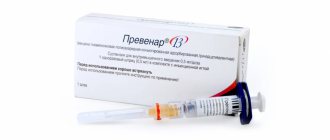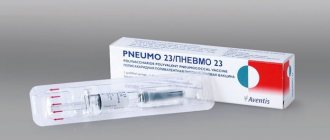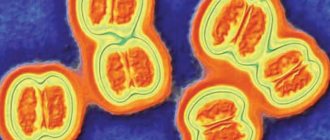Manufacturer: Merck Sharp & Dohme Corp., USA
For the prevention of diseases caused by pneumococcal infection in children over 2 years of age and adults
Facts about pneumococcal disease
The review is based on a review of the Federal clinical guidelines from April 2015.
- According to WHO, pneumococcal infection is recognized as the most dangerous of all vaccine-preventable diseases.
- Pneumococci are bacteria that cause otitis media, bronchitis, pneumonia, meningitis, and sepsis.
- In Russia, out of 500 thousand cases of pneumonia per year, 76% of adults and up to 90% of children under 5 years of age have pneumococcal etiology!
- When examining children under 5 years of age hospitalized in Moscow hospitals for acute bacterial infections (sepsis, bacteremia, meningitis, pneumonia, acute otitis, sinusitis), culture of samples in 47% of cases revealed S. pneumoniae (“streptococcus pneumonia"), which confirms its leading role in the structure of infectious diseases.
- Carriage of streptococcus in the nasopharynx is asymptomatic in most cases, but in children of the first years of life it may be accompanied by a runny nose.
- Unfortunately, a large number of antibiotic-resistant forms of streptococcus are currently being formed.
- According to the WHO position, the only way to significantly influence the morbidity and mortality from pneumococcal infection is to reduce the level of antibiotic resistance.
- Currently in Russia, vaccination against pneumococcal infection is carried out with 3 drugs - Prevenar, Pneumovax 23, Synflorix. Your pediatrician will tell you in more detail which drug is most suitable for a particular case at your appointment.
- Currently, vaccination is carried out from 2 months of age until old age. In pediatrics, vaccination is most relevant for children who are frequently ill, weakened, or when planning hospitalizations (at least 2 weeks in advance); for children with concomitant pathologies: bronchial asthma, heart defects, etc.
In our clinic, we vaccinate children against pneumococcal infection with an individual approach to their condition, and, if necessary, prepare for vaccination.
Vaccine Pneumovax 23
Manufacturer Merck Sharp and Dome Corp., USA
Description of the drug
The Pneumovax 23 vaccine (polyvalent pneumococcal vaccine) includes the main types of pneumococci that cause diseases with severe clinical courses (otitis media, sepsis, meningitis, pneumonia). The Pneumovax 23 vaccine is a mixture of purified capsular polysaccharides of the 23 most common types of pneumococcus.
Vaccination against pneumococcal infection is aimed at preventing the disease, as well as reducing complications from pneumococcal infection and deaths.
Indications for use
Prevention of diseases caused by Streptococcus pneumoniae in children over 2 years of age and adults.
Directions for use and doses
The vaccine is administered subcutaneously or intramuscularly once, the vaccination dose is 0.5 ml for all ages.
Compatibility with other vaccines
The Pneumovax 23 vaccine can be administered simultaneously with all drugs from the national calendar of preventive vaccinations on the same day, in different parts of the body, with the exception of the BCG vaccine.
Administering several vaccines on the same day does not place an excessive burden on the immune system. All vaccines in the Russian national vaccination calendar are interchangeable.
Primary immunization is a single dose.
The combination of vaccination with Pneumovax 23 with vaccination against influenza is effective for the comprehensive prevention of acute respiratory infections and preparation for the autumn-winter season.
Side effects
The most common adverse reactions are soreness, swelling, induration and redness at the site where the vaccine was administered. It is also possible for the body temperature to rise to febrile levels. Side effects from the administration of the Pneumovax 23 vaccine are short-term in nature and do not require any specific therapy other than symptomatic treatment.
pharmachologic effect
This drug is a pneumococcal polyvalent vaccine, which is used for prophylactic purposes - to prevent pneumococcal infections of various localizations.
In particular, the vaccine is intended for the prevention of pneumonia, meningitis , sepsis , and otitis media . The Pneumo 23 vaccination promotes the formation of specific immunity to twenty-three serotypes of Streptococcus pneumoniae bacteria.
After the Pneumo 23 vaccine has been administered once, a person has specific immunity for five years. The drug is widely used in children after reaching the age of two to prevent the development of pneumococcal infection in them.
brief information
Diseases of pneumococcal etiology are an urgent problem in practical healthcare, which is due to the leading role of Streptococcus pneumoniae in the structure of respiratory tract infections.
According to experts from the World Health Organization (WHO), these are the most common bacterial infections in adults in the world. S. pneumoniae continues to be a leading cause of serious illness, including bacteremia, meningitis, and pneumonia. Representing a serious medical and social problem for many countries, pneumococcal infections (PI) are also relevant for Russia. At the same time, the problem of PI in our country is given clearly insufficient attention, despite the existing achievements in this area, the main one of which is the creation of effective methods for the prevention of these infections, aimed at reducing the costs of treating diseases caused by pneumococcus and mortality due to this reason. The effectiveness of vaccination against PI, proven in numerous studies, made it possible to consider this event as promising and recommended for inclusion in the Calendar of Preventive Vaccinations.
Indications for use
The use of Pneumo 23 is indicated to prevent the development of pneumococcal infections of different localizations. Recommended for use by children from the age of two.
The vaccine is recommended for anyone who has an increased risk of becoming infected with Streptococcus pneumonia. In particular, this vaccination should be given to elderly people, children with weakened bodies, who are subject to frequent hospitalization.
Vaccination is also recommended for children who often suffer from diabetes , chronic bronchitis, respiratory and heart failure.
People who abuse nicotine and alcohol, those who have weakened immunity, and leakage of cerebrospinal fluid are also at risk of contracting the infection.
Definition
Pneumococcal infection is a group of ubiquitous anthroponotic diseases caused by the presence of airborne bacteria S. pneumoniae, which can penetrate the usually sterile environment of the human body, causing serious pathology with high mortality. There are 2 forms of PI - invasive (iPI) (meningitis, pneumonia with bacteremia, septicemia, septic arthritis, osteomyelitis, pericarditis, endocarditis) and non-invasive (pneumonia without bacteremia, acute otitis media, sinusitis, etc.) forms.
Contraindications
Vaccination with the drug should not be given to people who have a history of hypersensitivity after receiving the pneumococcal vaccine.
Immunization is not carried out for people suffering from acute infectious and non-infectious diseases, hyperthermia. The vaccine should not be administered during a relapse of chronic diseases.
Vaccination is allowed only after the patient has entered stable remission or has fully recovered.
The drug should not be administered to people who have received a pneumococcal vaccine over the previous three years (with the exception of people at risk, as well as those who have received immunosuppressive treatment).
It should be taken into account that a recent pneumococcal infection is not a contraindication to the Pneumo 23 vaccination.
Specific vaccine prevention of pneumococcal infection
Vaccination is recognized as the most effective method of preventing PI. According to the WHO position, vaccination is the only way to significantly influence the morbidity and mortality from PI and reduce the level of resistance to ALD. Having confirmed the safety and effectiveness of pneumococcal vaccines, WHO and UNICEF experts consider it necessary to include pneumococcal vaccines with a proven safety and effectiveness profile in all national immunization programs.
When carrying out VP PI, it is necessary to be guided by the current regulatory and methodological documents on the organization of immunization, primarily the National Calendar of Preventive Vaccinations and the Calendar of Preventive Vaccinations for Epidemic Indications, as well as instructions for the use of immunobiological drugs.
In the Russian Federation, vaccination against PI of all adults over the age of 50 years and patients at risk (including HIV-infected patients) is currently included as a mandatory measure in clinical recommendations and standards of medical care for therapy, cardiology, neurology, oncology, oncohematology, nephrology, pulmonology, allergology, immunology, endocrinology and transplantology.
Vaccination against PI is aimed at preventing the occurrence of generalized forms of pneumococcal infection (iPI), pneumonia, reducing morbidity, disability and mortality of the population from these infections. According to WHO data for different countries, it has been convincingly shown that specific CAP is the most accessible and cost-effective way to prevent PI. This is also confirmed by the results of domestic research.
Side effects
After the patient receives Pneumo 23, he may develop some local negative reactions: the appearance of compaction, swelling, pain, hyperemia in the place where the drug was injected.
In most cases, such manifestations are moderate and disappear very quickly, and no specific treatment is required.
Very rarely (in isolated cases) during the use of Pneumo 23, severe local manifestations may develop, including the Arthus phenomenon . All these side effects go away without additional treatment.
People whose bodies have a high level of anti-pneumococcal antibodies may develop hyperthermia, and sometimes, very rarely, the body temperature can rise to 39 degrees or higher.
There is information about isolated cases of arthralgia, adenopathy, skin rash and anaphylactoid reactions. If these or other undesirable manifestations develop, you should immediately inform your doctor.
Prevenar 13
(13-valent pneumococcal polysaccharide conjugated adsorbed vaccine for the prevention of diseases caused by Streptococcus pneumoniae)
Manufacturer: NPO Petrovax Pharm LLC (Russia)
Composition: each dose of the Prevenar vaccine contains purified polysaccharides of pneumococci of 13 serotypes, individually conjugated to the diphtheria carrier protein CRM197, and adsorbed on aluminum phosphate.
Release form: 0.5 ml of the drug in disposable syringes made of transparent, colorless borosilicate glass.
Indicated for use: for the prevention of diseases caused by Streptococcus pneumoniae serotypes 1, 3, 4, 5, 6A, 6B, 7F, 9V, 14, 18C, 19A, 19F and 23F (including sepsis, meningitis, pneumonia, bacteremia and acute otitis media ) in children aged 2 months to 5 years.
Vaccination schedule:
children aged 2 to 6 months . for individual vaccination according to the 3 + 1 revaccination scheme: 3 doses with an interval of at least 1 month, 1 dose is usually administered at the age of 2 months, the 4th dose (booster) is recommended to be administered at the 2nd year of life, optimally at 12-15 months; for mass vaccination according to the national vaccination calendar according to the 2+1 scheme: 1st dose at 2 months, 2nd at 4.5 months, revaccination at 15 months of life
children aged 7 to 11 months . according to the 2 + 1 revaccination scheme: 2 doses with an interval of at least 1 month, the 3rd dose is recommended to be administered at the 2nd year of life;
children aged 12 to 23 months . twice: 2 doses with intervals between doses of at least 2 months;
children aged 2 to 5 years once: 1 dose.
Contraindications: – hypersensitivity due to previous administration of the vaccine; – hypersensitivity to excipients and/or diphtheria toxoid; – acute infectious and non-infectious diseases, exacerbation of chronic diseases (in these cases, vaccination is carried out after recovery or in remission).
Advantages: – pneumococcal vaccine for newborns – helps protect the most vulnerable age group from the most common serotypes of pneumococcus, causing up to 80% of invasive pneumococcal infections; – the presence of a population effect has been proven—a reduction in morbidity among unvaccinated children and adults due to the formation of stable collective immunity; – one of the advantages of the drug is the binding of polysaccharides from the outer layer of the pathogenic bacterium to the “carrier” protein, which gives the vaccine permanent memory properties against many different types of pneumococci, including those that cause meningitis and pneumonia.
Prevenar can be administered to children simultaneously (on the same day) with other vaccines included in the National Vaccination Schedule (with the exception of BCG), as well as with the vaccine against Hemophilus influenzae type b (Hib), according to the prescribed immunization schedule.
Application experience : since 2000, it has been registered and used in 90 countries of the world, 38 countries have included Prevenar in the National Childhood Vaccination Calendars, more than 260 million doses of the vaccine have already been administered in the world. Use of this vaccine in the United States has resulted in a significant reduction in the incidence of pneumococcal disease not only among immunized children but also among the nonimmunized population by reducing transmission. The effectiveness of the new vaccination is especially high in preventing infection in the family with inflammatory diseases of the pharynx and ears. The vaccine protects against 40% of all known types of pneumococci. The safety of the vaccine is high and side effects are rare. They are common - this is temperature, and local - this is swelling, temperature and pain at the injection site.
Registered in Russia since 2011.
Vaccination Pneumo 23, instructions for use (Method and dosage)
The instructions for Pneumo 23 stipulate that the vaccine is used parenterally. This solution must be administered directly from the syringe in which the product is packaged by the manufacturer.
The drug is administered subcutaneously or intramuscularly. Please note that it cannot be administered intravenously.
It is imperative that this vaccine is administered in a specialized medical facility by a qualified specialist.
Before receiving a dose of the vaccine, the patient must be examined by a specialist. If a person has a feeling of general weakness, hyperthermia, or exacerbation of chronic diseases, vaccination should be postponed.
After the drug has been administered, the person must remain under the supervision of a specialist for 30 minutes. If he develops anaphylactoid reactions, the patient is given emergency treatment.
The general scheme for using the vaccine is determined by the doctor. As a rule, during the first vaccination, one dose (0.5 ml) of Pneumo 23 is administered.
Revaccination is advisable after at least three years. When revaccinating, a person should also receive one dose (0.5 ml) of the product.
The permissible interval (three years) between the administration of Pneumo 23 can be reduced for people who have an increased likelihood of developing pneumococcal infection, as well as for those who have recently received immunosuppressive therapy.
Epidemiology and features of clinical forms
According to WHO, PV is recognized as the most dangerous of all vaccine-preventable diseases (VP); Moreover, before the introduction of universal vaccination, PI was the cause of death for 1.6 million people annually, of which 0.7 to 1 million were children.
The case fatality rate for iPI can be high, ranging from 20% for septicemia to 50% for meningitis in developing countries. Mortality rates are highest in young children and people over 65 years of age.
Pneumococcus plays a primary role as the causative agent of pneumonia. According to foreign and domestic authors, this pathogen is the cause of 25–35% of all community-acquired and 3–5% of hospital-acquired pneumonia.
Community-acquired pneumonia is most severe in the elderly (with age, a person becomes more susceptible to the development of severe infections), as well as against the background of concomitant diseases (chronic broncho-obstructive, oncohematological cardiovascular diseases, viral infections, diabetes mellitus (DM), kidney and liver diseases , infection with the human immunodeficiency virus (HIV), alcoholism, etc.) Thus, the risk of developing iPI increases in bronchial asthma (BA) by 2 times, chronic obstructive pulmonary disease (COPD) - by 4 times, pulmonary fibrosis - by 5 times, sarcoidosis and bronchiectasis – 2–7 times. A direct relationship has been established between the frequency of iPI and age, smoking, and treatment with systemic or inhaled glucocorticosteroids. Elderly patients have a 3–5 times higher risk of death from pneumonia and its complications compared to young people
Workers of industrial enterprises with professional contact with metal fumes, mineral or any other dust or gaseous substances experience a rapid spread of respiratory infections and a severe course of these diseases. Contamination of the work area with aerosol particles makes a significant contribution to the development and spread of not only sporadic cases of PI, but also group diseases.
Patients with COPD account for 20.5–25.7% of those hospitalized with community-acquired pneumonia, with 30-day mortality accounting for approximately 9.6% of cases. Among patients admitted to hospitals for pneumonia, 15.8% have coronary heart disease (CHD), 14.3% have chronic heart failure, 9.6% have diabetes, with a mortality rate of 15–30%. The pathogenesis of the development of cardiac complications in pneumococcal pneumonia, which can lead to death, has been proven. Pneumonia caused by S. pneumoniae is most often complicated by pulmonary empyema and leads to death (up to ⅔ cases for empyema). The life-threatening form of PI is pneumococcal sepsis with the development of severe shock damage to organs. In the Russian Federation, 60% of sick adults over the age of 65 die from pneumococcal meningitis.
The transmission mechanism of pneumococci is aerosol, the route of transmission is airborne. The pathogen is transmitted from a source to susceptible individuals through close contact, coughing, sneezing, etc.
Most cases of PI are sporadic. Outbreaks of PI are typical for persons in the so-called. organized (closed) groups (children's homes, kindergartens, schools, student dormitories, military groups, institutions of the penitentiary system, long-term hospitals, boarding schools, homes for the elderly, etc.). In these same groups, the highest level of pneumococcal carriage is determined.
The distribution of PI incidence by month is uneven; the maximum incidence rate is recorded in the cold period of time (November–February), the minimum in the warm months (July–August). The intra-annual dynamics of the incidence of PI correlates with that of influenza and acute respiratory diseases.
Vaccine prevention remains the main means of containing the spread of PIs today.
special instructions
This vaccine is especially indicated for people who suffer from sickle cell anemia , as well as people with asplenia ; those who have recently had a splenectomy or people who are about to undergo a splenectomy.
It should be noted that if revaccination is carried out earlier than the required period, the person may experience severe local side effects after the injection.
Since there is a possibility of severe side effects (in particular, the Arthus phenomenon), before administering the drug, you need to evaluate the benefits of vaccination and take into account all contraindications.
If a person is receiving immunosuppressive treatment, the immune response to Pneumo 23 may be suppressed.
One dose of the vaccine provides effective protection.
The effectiveness of vaccine prevention
The effectiveness of any preventive measure, including CAP, is the degree to which the desired result is achieved through the implementation of this measure in the absence of side effects or their presence within established limits. The epidemiological, economic and social effectiveness of VP are highlighted.
The epidemiological effectiveness of CAP is determined by the degree of its influence on the epidemic process and is manifested in reducing morbidity and preventing the occurrence of new cases of infection among the population. When considering the epidemiological effectiveness of an event, it is customary to evaluate its potential and actual effectiveness.
The potential effectiveness of the VP is assessed by 2 main indicators: the efficiency index and the efficiency coefficient, or security indicator.
The index of the effectiveness of VP against a particular infection is the ratio of morbidity rates in the group of those vaccinated and those not vaccinated with this drug. It shows how many times the incidence rate of vaccinated individuals is lower than that of unvaccinated individuals.
The effectiveness coefficient characterizes the proportion of vaccinated individuals whose protection from infection was ensured by vaccination with this drug. The effectiveness coefficient is the most preferable indicator, since it shows only the effect of vaccination, without the influence of other preventive factors that may occur in the control and experimental groups.
The actual epidemiological effectiveness of CAP is determined by the actual reduction and prevention of morbidity as a result of CAP with a specific drug according to a specific regimen. The actual epidemiological effectiveness of VP is assessed during the period of its mass use. Assessing the actual effectiveness of EP is not a one-time study, but an ongoing analysis during epidemiological surveillance of infection, being a component of operational and retrospective epidemiological analyses.
The potential epidemiological effectiveness of VAP depends primarily on the immunogenicity of the vaccine, as well as on the choice of vaccination tactics and vaccination schedule.
The actual epidemiological effectiveness, assessed in real practical healthcare conditions with mass CAP, is usually lower than the potential effectiveness tested with optimal organization. The actual effectiveness is largely determined by the quality of the drug used and the quality of the organization and conduct of the event. The greater the difference between potential and actual effectiveness, the more reasons to doubt the quality of the means and measures and strengthen control over the EP. However, differences in effectiveness may be due to other reasons, for example, changes in the epidemiological situation, the evolution of the epidemic process of infection, which require changes in vaccination tactics.
The epidemiological effectiveness of VP PI has been assessed in numerous studies. Evidence in favor of the epidemiological effectiveness of vaccination is the decrease in the incidence of PIs in general and individual infections, primarily iPIs, recorded in various regions of the world.
Analogs
Level 4 ATX code matches:
Prevenar
Analogues of this vaccine are the drugs Prevenar , Prevenar 13 .
Only a doctor can choose the most optimal remedy after an individual consultation.
Prevenar 13 or Pneumo 23 - which vaccine is better?
The Prevenar 13 vaccine contains fewer serotypes than Pneumo 23. But reviews often contain information that when using Prevenar, local side effects occur more often.
At the same time, Prevenar 13, unlike Pneumo 23, can be administered to children up to two years of age. The attending pediatrician will tell you which vaccine is best to use to immunize a child.
The advisability of using these vaccines is described in more detail by specialists, for example, Dr. Komarovsky.
SYNFLORIX ® / SYNFLORIX ®
(Vaccine for the prevention of pneumococcal infections)
Manufacturer: GlaxoSmithKline Biologicals S.A. (Belgium)
Composition: active substances: conjugate of Streptococcus pneumoniae type 1 polysaccharide and Haemophilus influenzae D-protein, conjugate of Streptococcus pneumoniae type 4 polysaccharide and Haemophilus influenzae D-protein, conjugate of Streptococcus pneumoniae type 5 polysaccharide and Haemophilus influenzae D-protein, polysaccharide conjugate Streptococcus pneumoniae type 6B and Haemophilus influenzae D-protein, conjugate of Streptococcus pneumoniae type 7F polysaccharide and Haemophilus influenzae D-protein, conjugate of Streptococcus pneumoniae type 9V polysaccharide and Haemophilus influenzae D-protein, conjugate of Streptococcus pneumoniae type 14 polysaccharide and Haemophilus influenzae D-protein, con polysaccharide jugate of Streptococcus pneumoniae type 18C and tetanus toxoid, conjugate of Streptococcus pneumoniae polysaccharide type 19F and diphtheria toxoid, conjugate of Streptococcus pneumoniae polysaccharide type 23F and Haemophilus influenzae D-protein, excipients: sodium chloride, aluminum phosphate, water for injection
Release form White suspension, which separates when standing into a colorless transparent liquid and a white precipitate, which completely breaks up when shaken. Unbreakable flakes are not allowed.
Indications for use: prevention of pneumococcal infection caused by Streptococcus pneumoniae serotypes 1, 4, 5, 6B,7F, 9V, 14,18C,19F and 23F (including sepsis, meningitis, pneumonia, bacteremia), and infection caused by Haemophilus influenzea (acute otitis media) in children from 6 weeks to two years of age
Vaccination schedule: Children from 6 weeks to 6 months - Three-dose primary vaccination To achieve optimal protection, it is recommended to administer 4 doses of Synflorix vaccine, 0.5 ml each. The primary vaccination course consists of three doses, given with a minimum interval of 1 month between doses. The vaccine is usually administered at 2 months of age, but it is possible to administer the vaccine at an earlier age, starting at 6 weeks of age. A booster dose is recommended at least 6 months after the last primary dose, preferably between 12 and 15 months of age - Two-dose primary As an alternative schedule, the following vaccination schedule may be used: first dose (0.5 ml) given at age 2 -x months, the second dose (0.5 ml) is prescribed 2 months after the first dose. A booster dose is recommended at least 6 months after the last dose of primary vaccination.
Children not previously vaccinated with pneumococcal vaccine - from 7 to 11 months The course of vaccination consists of two doses of 0.5 ml with a minimum interval of 1 month between doses. Administration of the third dose is recommended in the second year of life with an interval of at least 2 months between administrations after the 2nd dose - from 12 to 23 months. The vaccination course consists of two doses of 0.5 ml with a minimum interval of 2 months between doses. Official recommendations must be followed during immunization with Synflorix. It is strongly recommended that children who receive the first dose complete the full course prescribed for Synflorix vaccination
Contraindications: – known hypersensitivity to any component of the vaccine and reactions to previous administration of the Synflorix vaccine; – children up to 6 weeks of age; – acute infectious diseases of moderate and severe severity.
During pregnancy and lactation
during the first and second trimesters of pregnancy . But if there are serious indications, immunization can be carried out in the third trimester of pregnancy under the close supervision of a doctor.
If a pregnant woman has been vaccinated, after administering the drug she should be under the supervision of a doctor for at least three hours.
Vaccination during lactation is acceptable. There is no need to interrupt breastfeeding.
Our doctors
Kedrinskaya Larisa Ivanovna
Experience 18 years / Doctor of the highest category, Candidate of Medical Sciences / General practitioner, cardiologist
Sign up
Shelkovnikova Maria Olegovna
28 years of experience / Candidate of Medical Sciences / General Practitioner
Sign up
+
Reviews about Pneumo 23
There are often opinions on the Internet about how effective the Pneumo 23 vaccination is. There are various reviews. Many parents write that after vaccination, the child began to suffer from infectious diseases much less. After vaccination, the diseases disappear quickly, without significant complications. It is important to vaccinate correctly and follow all doctor's advice.
Side effects are rarely mentioned in reviews; local manifestations are mainly noted, which quickly disappear. When discussing how effective the Pneumo 23 vaccine is, reviews from doctors are mostly positive.
The famous pediatrician Komarovsky, as well as other doctors, recommend vaccination to prevent the development of diseases.
Advantages of the Pneumovax 23 vaccine
- Vaccine against the 23 most common and invasive serotypes of Streptococcus pneumoniae.
- The vaccine is effective against pneumococcal serotypes that are the most common cause of antibiotic-resistant pneumococcal infections.
- A single vaccination is required.
- The introduction of the vaccine leads to the rapid appearance of specific antibodies, which after 3 weeks provide immunity to infection lasting 5-10 years.
- 57% protective effectiveness of vaccination against invasive infections caused by serotypes included in the vaccine in children over 6 years of age.
- Mild side effects.










